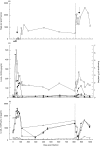Immune responses following experimental human hookworm infection
- PMID: 16232230
- PMCID: PMC1809522
- DOI: 10.1111/j.1365-2249.2005.02945.x
Immune responses following experimental human hookworm infection
Abstract
To characterize the immune response following primary human hookworm infection, an adult volunteer was infected with 50 L3 larvae of Necator americanus, reinfected 27 months later and followed for a further 6 months. Clinical signs, blood picture, ex-vivo peripheral blood cytokine production (IFN-gamma, IL-5, IL-13, IL-10 to mitogen and hookworm antigen), acute phase proteins (APP) (C-reactive protein, CRP and alpha1-antitrypsin, alpha1-AT) and antibody levels were determined. Dermatitis, oedema, mild nausea and abdominal discomfort followed the primary infection. Eosinophil counts peaked early during both infections but remained elevated ( approximately 18%) throughout. Transient production of IL-5, IL-13 and APP also followed infection but there were negligible levels of IFN-gamma or IL-10. The onset of nausea, oedema and the initial rise in CRP, alpha1-AT, eosinophilia and IL-5 coincided (days 13-27) with the late larval migration and early establishment of the preadult worms in the intestine. Apart from the eosinophilia these responses declined to baseline levels within 4 months and were less pronounced on re-infection.
Figures

Similar articles
-
Immune responses in human necatoriasis: association between interleukin-5 responses and resistance to reinfection.J Infect Dis. 2004 Aug 1;190(3):430-8. doi: 10.1086/422256. Epub 2004 Jun 25. J Infect Dis. 2004. PMID: 15243914
-
Early stage-specific immune responses in primary experimental human hookworm infection.Microbes Infect. 2008 Nov-Dec;10(14-15):1524-35. doi: 10.1016/j.micinf.2008.09.003. Epub 2008 Sep 23. Microbes Infect. 2008. PMID: 18848637
-
Acquired hookworm immunity in the golden hamster (Mesocricetus auratus) elicited by living Necator americanus third-stage infective larvae.Exp Parasitol. 2012 Jan;130(1):6-12. doi: 10.1016/j.exppara.2011.10.007. Epub 2011 Oct 21. Exp Parasitol. 2012. PMID: 22024448
-
The immunoepidemiology of human hookworm infection.Parasite Immunol. 2004 Nov-Dec;26(11-12):443-54. doi: 10.1111/j.0141-9838.2004.00727.x. Parasite Immunol. 2004. PMID: 15771680 Review.
-
[Immunity in hookworm infection].Zhongguo Ji Sheng Chong Xue Yu Ji Sheng Chong Bing Za Zhi. 1994;12(4):303-6. Zhongguo Ji Sheng Chong Xue Yu Ji Sheng Chong Bing Za Zhi. 1994. PMID: 7720209 Review. Chinese. No abstract available.
Cited by
-
C-reactive protein is differentially modulated by co-existing infections, vitamin deficiencies and maternal factors in pregnant and lactating indigenous Panamanian women.Infect Dis Poverty. 2017 Jun 2;6(1):94. doi: 10.1186/s40249-017-0307-1. Infect Dis Poverty. 2017. PMID: 28571565 Free PMC article.
-
IL-4Rα-associated antigen processing by B cells promotes immunity in Nippostrongylus brasiliensis infection.PLoS Pathog. 2013 Oct;9(10):e1003662. doi: 10.1371/journal.ppat.1003662. Epub 2013 Oct 24. PLoS Pathog. 2013. PMID: 24204255 Free PMC article.
-
Potential anthelmintic effect of chitosan on Syphacia muris infecting Wistar rats: biochemical, immunological, and histopathological studies.Sci Rep. 2024 Feb 3;14(1):2825. doi: 10.1038/s41598-024-52309-8. Sci Rep. 2024. PMID: 38310115 Free PMC article.
-
Glycoconjugates in host-helminth interactions.Front Immunol. 2013 Aug 28;4:240. doi: 10.3389/fimmu.2013.00240. eCollection 2013. Front Immunol. 2013. PMID: 24009607 Free PMC article. Review.
-
Evidence of microbial translocation associated with perturbations in T cell and antigen-presenting cell homeostasis in hookworm infections.PLoS Negl Trop Dis. 2012;6(10):e1830. doi: 10.1371/journal.pntd.0001830. Epub 2012 Oct 4. PLoS Negl Trop Dis. 2012. PMID: 23056659 Free PMC article.
References
-
- Pritchard DI, Quinnell RJ, Walsh EA. Immunity in humans to Necator americanus. IgE, parasite weight and fecundity. Parasite Immunol. 1995;17:71–5. - PubMed
-
- Cooper PJ, Chico ME, Sandoval C, et al. Human infection with Ascaris lumbricoides is associated with a polarized cytokine response. J Infect Dis. 2000;182:1207–13. - PubMed
-
- Pit DS, Polderman AM, Baeta S, Schulz-Key H, Soboslay PT. Parasite-specific antibody and cellular immune responses in human infected with Necator americanus and Oesophagostomum bifurcum. Parasitol Res. 2001;87:722–9. - PubMed
-
- Faulkner H, Turner J, Kamgno J, Pion SD, Boussinesq M, Bradley JE. Age- and infection intensity-dependent cytokine and antibody production in human trichuriasis: the importance of IgE. J Infect Dis. 2002;185:665–72. - PubMed
-
- Quinnell RJ, Pritchard DI, Raiko A, Brown AP, Shaw MA. Immune responses in human necatoriasis: association between interleukin-5 responses and resistance to reinfection. J Infect Dis. 2004;190:430–8. - PubMed
Publication types
MeSH terms
Substances
LinkOut - more resources
Full Text Sources
Research Materials
Miscellaneous

